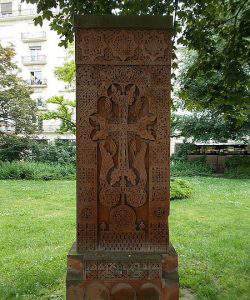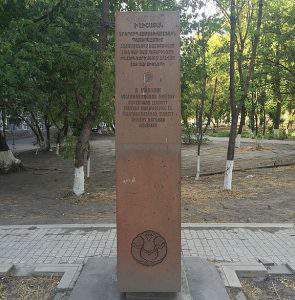Minorities in Hungary #6 – Armenians

Coming relatively late compared to Croatians or Poles the first Armenian settlers arrived in Hungary in the 13th century. At least that is what the first records about a settlement named Terra Arminium suggest. Some chronicles also mention Armenians coming to the Carpathian Basin alongside Árpád’s army, but probably only in smaller numbers.
The first direct contact between Hungarians and Armenians was when King Andrew II’s crusaders reached Armenia. After the conquest, Andrew II intended to marry his son to the daughter of Armenian king Levon II. The Hungarian king returned to his homeland, bringing a considerable number of Armenian settlers to the area of Esztergom: that was the region where Terra Arminium was founded.
The most obvious signs marking Armenian population can be found in the names of settlements, like the famous Örményes (“örmény” means Armenian in Hungarian).
Another wave of Armenian immigrants worth mentioning came to Transylvania between the 11th and 14th centuries — though there are not too many sources about them. They fled to Hungary from the disasters striking their homeland: the Seljuq assault in 1064, the Mongolian raids in 1236 — which reached Hungary as well, only five years later — and an earthquake destroying the city of Ani. The population of the City of 1001 Churches moved to the Caucasian region first, continuing their journey through Crimea and Moldavia, finally ending up in Hungary.

The first time when Armenians were considered full members of the Hungarian society was after 1672 when they received a right to settle and certain privileges from Prince Mihály Apafi. The main reason for their flight was the attempted uprising against Romanian Prince Gheorge Dúca, which was defeated with Ottoman help, and many Armenian officers took part in it. The cruellest reprisal threatened them, so they sought shelter in Transylvania.
The largest number of the immigrants came during the 18th century, when Armenians arrived in great masses from Moldavia.
Concerning their professions, most of the Armenian settlers were mostly craftsmen, e.g. skinners, tanners and merchants. The skills of Armenians on the field of tanning was legendary, and they have dominated almost the entire skin market in Hungary, especially in Transylvania. Thanks to their contribution to building the Hungarian economy and their professionalism in commerce, more than 50 Armenian families received or purchased noble rank by the end of the 19th century. Their society, however, had different customs from the customs of the Hungarian population, as the Armenian communities were partly ruled by the priesthood, who represented not only clerical but also political power.
The greatest Armenian participation in the Hungarian history was probably the War of Independence in 1848-’49, when more than 200 soldiers fought on the Hungarian side. These include officers Ernő Kiss and Vilmos Lázár, who were both executed in Arad among the Thirteen.
Currently, regular Armenian Catholic masses are only hosted in Budapest. There are not any organised clerical Armenian communities in Hungary outside the capital. There are four settlements in Transylvania having Armenian Catholic churches, but none of them has a proper clergyman. The Armenian Catholic Church follows the Latin customs, celebrating Christmas and Easter with unique Armenian liturgies. The Armenian clerical tradition’s most important holiday is the day of Saint Gregory, the Illuminator, who was the first Armenian converter.
The greatest Armenian festival in the Hungarian speaking territories is arguably the annual gathering of Armenians in Szamosújvár (Gherla), Transylvania.
Armenians come together then from not only Hungary but also from all around the world. There is a reason why Szamosújvár serves as the event’s venue, as the most significant Armenian Catholic church can be found in this city. Moreover, Szamosújvár has been the centre of Armenian life in the region for such a long time that it was referred to as “Armenopolis”.

The Armenian language belongs to the Indo-European languages, but it does not have any close relatives among the other languages. It has two main dialects: East and West Armenian. East Armenian is mostly spoken in Iran, India and the former Soviet territories, including Armenia herself. In Hungary, however, West Armenian is the most widespread, as in many other territories in Europe where Armenian refugees fled through.
There have been several artists in Hungary from Armenian origin who became famous as Hungarians, such as dramatist Gergely Csiky, award-winning actor Gábor Agárdy or world-famous animation director Marcell Jankovics.
In 2001, only 294 Hungarian citizens reported themselves as having Armenian as their mother tongue, 620 people claimed that they belonged to the Armenian nation, and 1,136 was reported to relate to the Armenian culture and traditions. Still, about 32,000 voted for Armenian candidates at the minority municipal elections in 1994. These votes are likely to come from Hungarian citizens with Armenian roots.
As in the case of many other minorities, it is difficult to determine their exact number. All we can conclude is that assimilation affected Armenians relatively acutely compared to many other ethnic groups in Hungary, as this culture is not represented significantly anywhere within the country’s borders. Though they remain somewhat “invisible” within Hungarian society, their past contributions to Hungarian history and economy make Armenians vital parts of Hungary’s society.
Source: Ararat.hu, Országos Örmény Önkormányzat, Emberijogok.kormany.hu, Daily News Hungary






[…] Coming relatively late compared to Croatians or Poles the first Armenian settlers arrived in Hungary in the 13th century. At least that is what the first records about a settlement named Terra Arminium suggest. Some chronicles also mention Armenians coming to the Carpathian Basin alongside Árpád’s army, but probably only in smaller numbers, Daily News Hungary reported. […]
I speak Western Armenian since I am a Lebanese Armenian living in Hungary. All the Armenians I met in Hungary speak Eastern Armenian, so I guess the article should be edited for saying Armenians in Hungary speak West, it should be Eastern dialect.
Thank you.
Your first paragraph needs to be rewritten. Andrew II never conquered Armenia (as can be interpreted from what is written). However, on the way back to Hungary, he stopped in Cilicia, where Andrew II and the Armenian king Levon II betrothed Andrew’s son Andrew Levon’s daughter Isabella.